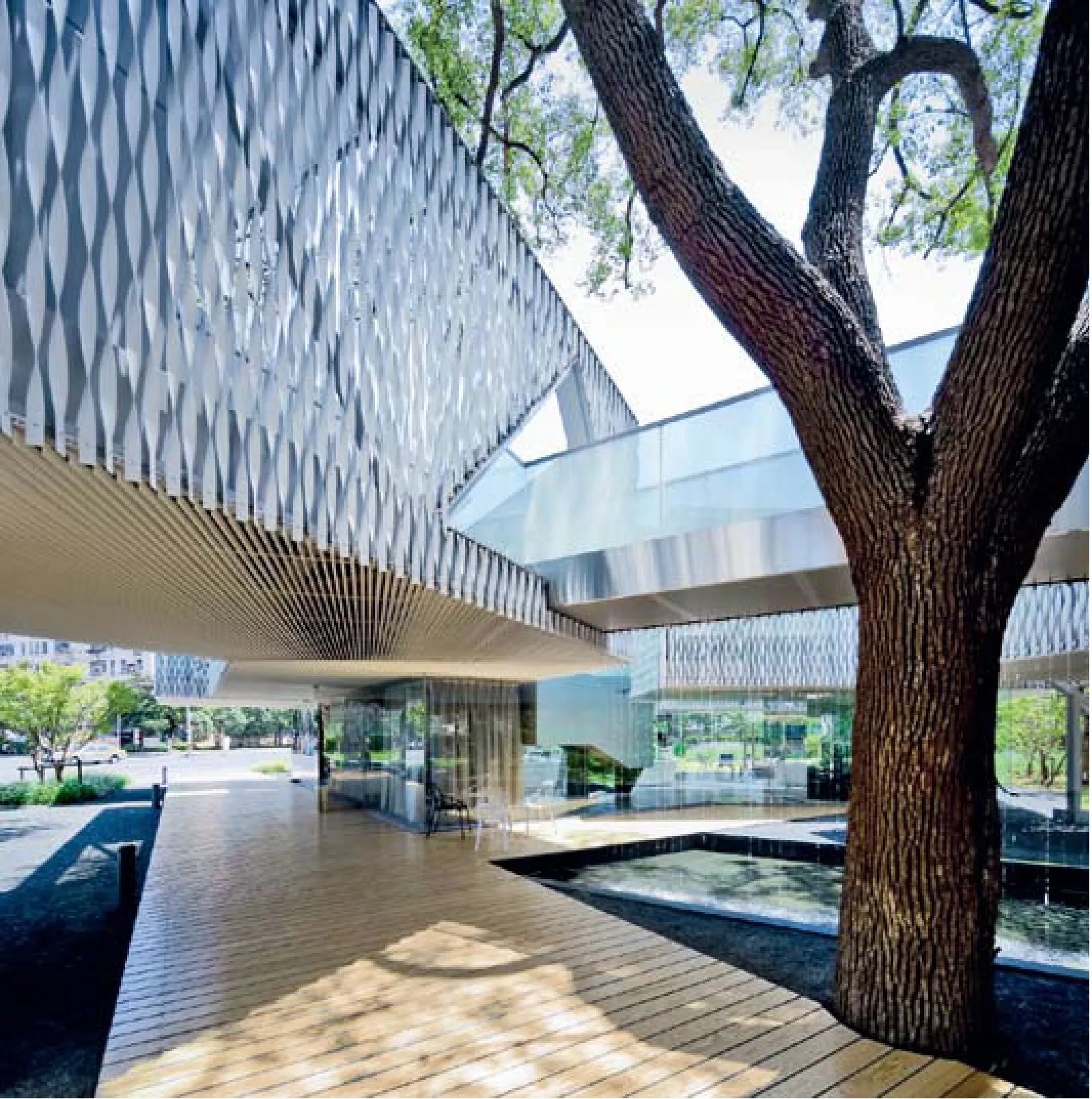华鑫展示中心,上海,中国
华鑫展示中心,上海,中国
Huaxin Exhibition Center, Shanghai, China, 2013
建筑设计:祝晓峰,丁鹏华,蔡勉,杨宏/上海山水秀建筑设计顾问有限公司
Archiects: ZHU Xiaofeng, DING Penghua, CAI Mian, YANG Hong/Scenic Architecture Office

1 水院/Water courtyard

2 内景/Interior view
华鑫办公集群位于桂林路西,其入口南侧是一块绿地。这块绿地面向城市干道的开放属性,以及其中的6棵大香樟,成为了设计的出发点,并由此确立了展示中心的两个基本策略:(1)建筑主体抬高至二层,最大化开放地面的绿化空间。(2)保留6株大树的同时,在建筑与树之间建立亲密的互动关系。
最终完成的建筑由4座独立的悬浮体串联而成。底层的10片混凝土墙支撑着上部结构,其表面包敷的镜面不锈钢映射着外部的绿化环境,从而在消解自身的同时,凸显了地面层的开放和上部的悬浮感。
沿着中庭内的折梯抵达二层,会进入一种崭新的空间秩序。4个悬浮体的悬挑结构由钢桁架实现,它们在水平方向上以“Y”或“L”形的姿态在大树之间自由伸展。由波纹扭拉铝条构成的半透“粉墙”,以若隐若现的方式呈现了桁架的结构,并成为一系列室内外空间的容器和间隔。大树的枝叶在建筑内外自由穿越,建筑的结构、材质,和大树的枝干、树叶交织在一起,一起营造出一个个纯净的室内外空间。这些空间(屋和院)在时间(路径)的组织下,共同实现了时空交汇的环境体验。这是一件由建筑和自然合作完成的作品。
This building is designed to enlighten us on the connection among human, nature and the society.
Huaxin office complex is located to the west of Guilin road, with a green space to the south of its entrance. The openness of this green space to the city’s main road together with the six old camphor trees in it inspired the design. Hence, two basic strategies are established for the exhibition center. One is to elevate the main building to the second floor in order to maximize the green open space on the ground level. The other is to preserve the six old trees and establish an intimate and interactive relationship between them and the building.
The completed building is composed of four independently suspended structures that are linked by bridges. The upper structures are supported by ten pieces of concrete walls, which are covered with mirror finished stainless steel panels reflecting the surrounding green environment. While dissolving their own volumes, these walls highlight the openness of the ground level and the suspension effect of the upper portion.
Approaching the second floor through the staircase in the atrium, a new spatial sequence is unfolding along the path. The four suspended volumes supported by steel trusses stretch horizontally in between the old trees in a "Y" or "L" shape. Twisted and tensioned aluminum strips make up the translucent walls of these volumes, presenting the truss structure in a partly hidden and partly visible manner and defining and dividing a series of interior and exterior spaces. The structure and material of the building interwoven with the branches and leaves of the trees which go in and out of the building form a series of pure spaces, both exterior and interior. It is under the organization of time (or path) that these spaces (rooms and courtyards) provide the visitors an environment with a time-space combined experience. It is a work collaboratively done by both architecture and nature.
项目信息/Credits and Data
客户/Client: 华鑫置业/China Fortune Development Co., Ltd.
设计团队/Project Team: 上海山水秀建筑设计顾问有限公司(建筑设计)/祝晓峰(设计总监);丁鹏华(设计主管);蔡勉,杨宏,李浩然,杜士刚(建筑师)/上海绿地建筑钢结构有限公司(结构与机电设计)/Scenic Architecture Office (Architectural Design)/ZHU Xiaofeng (Principal Architect); DING Penghua (Project Designer); CAI Mian, LI Haoran, DU Shigang (Architects)/Shanghai Greenland Building Steel Structure Ltd. (Structural & MEP)地点/Location: 上海市徐汇区桂林路宜山路/Guiling Road and Yishan Road, Xuhui District, Shanghai
建筑面积/Floor Area: 730m2
用途/Feature: 展览,茶室/Exhibition, Teahouses
结构形式/Structure: 钢骨混凝土剪力墙,钢桁架结构/ SRC, bended steel truss
材料/Material: 镜面不锈钢,扭拉铝条,透明及丝网印刷玻璃,实面及穿孔铝板,豆石,水/Mirror finish stainless steel, twisted and tensioned aluminum strip, transparent and fritted glass, solid and perforated aluminum panel, gravel, water
设计时间/Design Period: 2012
摄影/Photos: 苏圣亮/SU Shengliang

3 北侧外景/Exterior view from the north

4 首层平面/Floor 0 plan

5 二层平面/Floor 1 plan

6 总平面/Site plan

7 香樟与连桥/Camphor tree and the bridge

8 剖面/Section

9 茶座/Tea house
评委评语
该项目是小型公共展示中心,位于城市干道开放绿地,其特点是充分体现建筑与自然、建筑与人、建筑与社会之间的关联。设计的两个基本策略:一是建筑主体抬高至2层,最大化开放地面的绿化空间;二是保留6株大树的同时,在建筑与树之间建立亲密的互动关系。为此,在建筑技术手段上,底层10片混凝土墙撑起上部钢结构,并收纳了所有垂直上下的设备管道,尽可能消解与地面的存在感;2层由4座独立的悬浮体串联而成,悬挑的钢桁架保证了结构的轻盈通灵的效果,其室内外空间与外部树林和自然交融为一体。
特别要指出的是,为了尽量减少对树林根系的伤害,设计充分考虑了基础的位置和结构形式(浅而宽)。在这里,建筑的结构、材质和大树的枝干、树叶交织在一起,共同营造出一个由建筑和自然合作完成的作品。
Jury Statement
This project is a small-scale public exhibition center, located in an open green space adjacent to a city artery. The primary feature of the project is to fully present the connection between architecture and nature, architecture and human, and architecture and society. The two fundamental design strategies include elevating the main building to the second floor to maximize the green space on the ground level, and establishing a close and interactive relationship between the building and the six old trees which are preserved on site. Hence, in terms of construction technologies, ten concrete walls are built to support the steel structure above, and to enclose all vertical equipment pipelines so as to minimize their presence on the ground level. The second floor is composed of four independently suspended structures which are linked with each other. The overhung steel trusses ensured the light and airy effects of the building. As a result, the exterior and interior spaces of the building are successfully integrated with the trees and nature around it.
It needs to be pointed out that in order to reduce damage to the tree roots, the location and structural form (shallow and wide) of the foundation is given careful consideration. In this project, the structure and material of the building are interwoven with the trunks and branches of the old trees. It is a work jointly created by the architecture and nature.

